Shima, Mie, Japan – Friday, June 17th, 2011
Approaching week three of solo travel was becoming a test of determination. Money was tight, energy was waning, and questions were forming. Why was I putting so much effort to visit this small park in a relatively remote location along the eastern coast of Japan for a day? It would certainly be a lot easier (and cheaper) to just *not* go. I had put Parque España on my list of places I wanted to go when I was feeling excited and ambitious about the whole concept, but now that I was actually in it day after day, I was beginning to have doubts. It wasn’t that high on my priority list, and while the B&M inverted coaster got a lot of attention from coaster fans, I was actually skeptical that my personal appraisal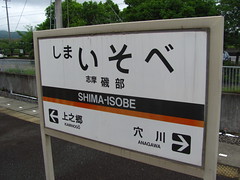 would be nearly as high. Maybe I wanted to go so that I could write a review and ‘prove’ everyone wrong about it? It obviously wasn’t that big of a motivation because it took me nearly a decade to get around to that task. Maybe it’s just the list-making, completionist mentality? Once it became a “thing” for me to do, I couldn’t not do it without leaving a part of me incomplete. Or maybe there was still a small authentic spirit of curiosity and joie-de-vivre left at the core of whatever anxiety and exhaustion I was feeling. One always has to be somewhere in the world as a result of intentional choice of actions, and somehow I came to the true determination that I would best find meaning and value by spending this particular day at Parque España-Shima Spain Village.
would be nearly as high. Maybe I wanted to go so that I could write a review and ‘prove’ everyone wrong about it? It obviously wasn’t that big of a motivation because it took me nearly a decade to get around to that task. Maybe it’s just the list-making, completionist mentality? Once it became a “thing” for me to do, I couldn’t not do it without leaving a part of me incomplete. Or maybe there was still a small authentic spirit of curiosity and joie-de-vivre left at the core of whatever anxiety and exhaustion I was feeling. One always has to be somewhere in the world as a result of intentional choice of actions, and somehow I came to the true determination that I would best find meaning and value by spending this particular day at Parque España-Shima Spain Village.
After arriving at the train station, a short bus ride was needed to reach the park, which was fortunately well-marked in English.
Like Space World a few days ago, Parque España-Shima Spain Village is a single-theme theme park that’s 100% about Spain. This came about because Mie prefecture has a sister relationship with Valencia, Spain, which provides the park with more authentic resources including architectural guidance, artifact collections, and a handful of Spanish native workers and performers. The park also opened in 1994, at a time when Japanese audiences still preferred to re-create different parts of the world with all the comforts and proximity to home, rather than actually have to travel there themselves.
For a park its size, basing it off a single theme can lead to a little bit of over-saturation, well exceeding anything found in an Epcot World Showcase, a Europa-Park zone, or a Busch Gardens Williamsburg hamlet. But it also means there’s room to riff on more minor variations that would probably be overlooked if presented at other theme parks. Yes, the Baroque Madrilenian building and plaza style you would expect from a Spanish theme park is all there in grand form around the entrance.
But then you also get stuff like a Gaudí-inspired section that’s full of funky Catalan modernism vibes.
Along with some quieter, rustic areas.
And some medieval style structures as well.
The Museo Castillo de Xavier was named after Francis Xavier, who was the first Christian missionary to go to Japan. (I highly recommend Martin Scorsese’s Silence for more on this period of Japanese history.) This was perhaps the most unique attraction to find in a regional theme park, filled with historic and cultural artifacts on loan from Spain, including an area based on Madrid’s Prado museum.
However, the style of theme park design based on foreign countries exemplified by Parque España and other places like Huis Ten Bosch has been in decline in more recent decades. Known as “yofu” (meaning Western-style architecture made in Japan), today is viewed by many Japanese as tacky and inauthentic, overused during the 80’s and 90’s despite having a long history on these islands that predates theme parks. Perhaps as a partial result, Parque España-Shima Spain Village was really dead. Perhaps the emptiest theme park I’ve ever visited relative to its size.
A parade came through and the performers FAR outnumbered the audience. Calling it a bit awkward as a lone spectator would be a gross understatement.
Of course this wasn’t the first (or last) time I encountered an empty theme park in Japan. I’ve heard a few theories about why many regional Japanese theme parks are this way and yet still seemingly management to survive. First, I obviously had to consider the particular time I visited, during what’s normally a shoulder season in Japan just few months after the most powerful earthquake and tsunami to ever strike Japan, as well as the active Fukushima nuclear disaster that required me to cancel any plans I had made to venture north of Tokyo. Even the ‘busy’ parks I visited like Universal and Disney had much more manageable crowds than virtually any other report I’ve ever seen from those parks at other times before or since.
Second, I’ve heard that Japanese theme parks, similar to other Asian countries, tend to have more ‘peak’ attendance patterns, where during certain public holiday periods the parks will suddenly cram in loads of visitors and make the majority of their revenues in just a few weeks out of the year. However, due to Japanese labor laws that require stable, long-term employment, they still have to remain nearly fully staffed and opened for the rest of the days of the year when fewer guests are likely to show up, such as today. While I don’t disagree that could be a rationale for the way Japanese theme parks are, I also don’t find it a very convincing argument for their long-term economic sustainability. Amusement and theme parks by the way they function are not built to accommodate huge swings in demand like an arena, and having a high overhead the rest of the year, whether or not it’s legally required or part of the culture, is still a liability for these businesses.
Third, perhaps my favorite theory if only because it’s fascinating to imagine a movie based on this idea, is that many of these regional Japanese parks are in fact fronts for the Yakuza to launder money, given the many points of sale within the gates and how easy it is to fudge attendance numbers. Even with how strict many Japanese parks are over guests displaying tattoos or anything else that could indicate gang affiliation, it perhaps would make sense as the perfect cover. I’m not saying that’s actually the case, just an idea I’ve heard to explain why these seemingly empty theme parks can still remain in business all these years.
Anyway, let’s get on to the rides. One of the first major attractions to encounter inside the park is the Bullfight Roller Coaster Matador.
Being an older Japanese coaster with large boxy shoulder harnesses, the sensation of being caught in the middle of a bullfight serves as an apt theme.
What happens on the ride is just as weird. While it mostly takes place in pitch darkness, there’s several red capes as illuminated scenic effects that flash as you pass by, apparently suggesting that riders are aboard the bull. About 3/4 of the way through the ride, it makes an extended stop in a narrow bullfighting coliseum, as you hear the trumpet fanfare and crowd cheering, the figures illuminated as black silhouettes against a red light background. Eerie and dreamlike, like the final ecstatic moments before death. As the finale, the coaster charges ahead one last time, this time flying by a giant bullfighter’s sword pointed right at us. The cars suddenly hit the brakes and the exit spiel plays. Just like any good arthouse movie, I think the ending represents death… but it’s not very clear? Truly a surreal coaster. The ride has since gotten a revamped name and theme as “Steampunk Coaster Iron Bull,” which on paper sounds even weirder, although I’m guessing the ride no longer serves as a thematic interpretation of a bovine euthanasia coaster.
Gran Montserrat is a Mack Rides mine train coaster that’s been at the park since it opened in 1994.
The layout strongly resembles the Vekoma mine trains, with the side-by-side lift hills surrounded by a fairly compact layout of curves and helices. However, the riding experience itself is quite different. Very smooth, and with the flat lattice track it reminds me much more of a classic Schwarzkopf Speed Racer coaster, such as the Whizzer at Six Flags Great America.
Gran Montserrat does however lack some of nuance of a Schwarzkopf design, being a rather repetitive series of indistinct curves and helices with little variation at any point along the way. The thematic design of the mountain is a little lacking as well. After Bullfight Roller Coaster Matador, Gran Montserrat was much more comfortable and pleasing in the moment, but also basic and forgettable after it was over. You don’t even get to pretend you died for public spectacle on this one.
The mountain structure for Gran Montserrat is shared by a log flume named Splash Montserrat.
Like Gran Montserrat, Splash Montserrat is a decent if unremarkable flume ride, featuring two lifts and drops with a long meandering section in between. There’s relatively little to look at except for some fake rock facades and the structure for Gran Montserrat overhead. The entire length of the trough is covered on the outside by fake rocks, which would show a bit of extra effort except it can’t really be appreciated from inside the trough, and most of the layout goes back into areas where spectators can’t view it unless they’re on the roller coaster.
Now the big one. Despite the park’s many unique charms, I doubt I would have ever made the effort to come here if it didn’t have Pyrenees, a B&M inverted coaster added in 1997.
Interestingly, despite being a relatively early design, Pyrenees was only the fourth B&M inverted coaster to be built in Japan, although it was the first custom-designed one.
Pyrenees fits in with the many other mid/late-90’s inverted coasters, with a layout that’s reminiscent of Batman and Raptor spliced together, but done at a scale and style most closely approximating Montu. With all of those comparisons in mind, it’s of course little surprise that Pyrenees is held in high regard by coaster enthusiasts who have traveled all the way to Shima, Japan.
The themed design is fairly minimal compared to other attractions in the park. Pyrenees is named after the tallest mountain range in Spain, I suppose in contrast to the nearby Gran Montserrat which is named after a smaller mountain range near Barcelona. Naming your coasters after mountains seems like an obvious if kinda basic idea.
After a 147 foot tall lift hill, the ride first resembles a dramatically enlarged Batman layout, with a vertical loop, zero-G roll, vertical loop combo sequence.
After that it turns into more of a Raptor-like design, with a short ground-skimming section leading into a cobra roll, followed by an aerial helix up into the midcourse block brake. It even threads one of the vertical loops, a nice touch. So far pretty good.
Here’s where Pyrenees loses any potential claim to top-tier B&M status: the post-midcourse layout represents perhaps the most abrupt downgrade in ride quality of any B&M coaster I’ve been on. Start with the curving drop out of the brakes, with a weird kink in it which quite literally feels like two separate sections stapled together.
This dives straight down into a flatspin corkscrew sitting out by itself. Fine, whatever. Not a very clever approach but it could serve as decent opener to the second half.
Instead there’s a rather lazy banked turn into a long descending straight ramp. This could have been a good way to build speed and anticipation for a grand finale, but instead it disintegrates into nothingness with an ineffectual small bunny hill over the queue. There’s no further payoff, no final inversion or helix or anything, just another simple banked turn into the brakes. The entire final third of the ride manages to be one long, sustained anti-climax. Almost impressive really how a ride that starts out promising could end on such a note of nothingness.
I guess if you excise from your memory everything after the midcourse brake, you’ve got a pretty decent first half to an old-school 90’s B&M inverted coaster. (“Pretty decent” is still far from “sublime.” Let’s not get too carried away about that extra vertical loop.)
However, the fact that the ride is so inconsistent with such a flat finale means that I would probably rank Pyrenees at (or near) the bottom for custom-designed B&M inverted coasters from that decade. Yes, it combines aspects we all like from Batman, Raptor, and Montu, but those individual coasters are also all perfectly great on their own, and they all tend to sustain themselves much better to the final brakes. Even other 90’s inverts with weaker finales like Alpengeist or Great Bear still manage to make up for it in other regards that are much more singularly unique. This is hardly a bad ride, but I’d still consider Pyrenees as a minor, forgettable work by the Swiss masters.
Even if Pyrenees isn’t the Holy Grail for coaster enthusiasts, there’s still a lot of interesting discoveries at Parque España for theme park fans. Let’s start with the Illumination Ride: The Nutcracker, a Christmas themed dark ride based on Tchaikovsky’s The Nutcracker ballet. (And sponsored by Asahi beer!)
You ride in what appears to be a Christmas cracker, mostly sideways but the vehicle is capable of pivoting like an omnimover during the ride.
Based on a Russian ballet, the connection to Spain is somewhat tenuous apart from some seemingly misplaced Spanish dancers near the end of the ride. Aside from some simple media effects and a few larger set pieces, the story of Nutcrackers and mice kings is largely told via painted flat panels strung up with thousands of flashing Christmas lights.
I later learned that this attraction replaced a much more fascinating dark ride using the same ride system, the legendary Donkey’s Sherry. The ride’s storyline was somewhat hard to parse, but it apparently took us through the vivid dream of a donkey drunk on a barrel of sherry, as it imagines itself as a donkey conquistador before encountering a giant robot donkey finale with laser beams shooting out of its eyes.
This medieval citadel contained a spooky interactive dark ride, named Batalla Del Alcazar – Adelante.
Don Quixote’s Magical Flight is the park’s take on a Peter Pan style inverted dark ride. It’s fairly well-made for what it is and not particularly derivative of the Disney attraction despite the initial appearance of flying pirate ships. The ride features several cleverly designed scenes and a respectably large number of sculpted figures based on its cast of Spanish cartoon characters found throughout the park. Much better than the Nutcracker.
These character mascots also feature within the park’s live entertainment.
The largest dark ride at Parque España was the Adventure Lagoon, which could be described as a Pirates of the Caribbean-style boat ride except it again has many unique features to completely distinguish it from simply being a “Disney knock-off.”
To start with, there’s a long outdoor section in a medium-sized lagoon, riding in boats with canopies.
Once you head inside there’s a lift hill, and the typical Pirates antics give way to a Atlantis-inspired undersea journey, apparently to meet Neptune. (Basically, it’s the story for Shanghai’s Battle for the Sunken Treasure many years before that opened, so perhaps Disney is the knock-off attraction in this case.)
But the most unique feature is the final drop, which enters a chamber filled with waterfalls on all sides before a tilt track reveals a secret opening below the waterfalls, and then releases the boat into the splashdown, like a miniature aqua version of Gravity Max. Both unexpected and a surprisingly exciting finale!
Unfortunately this feature may have also led to mechanical issues, as the following year Adventure Lagoon was permanently closed and later replaced with a new ride called Feliz Cruise that reused the boats and outdoor lagoon but didn’t go into the building. Glad I got to ride it while it was still around.
Last of note, is a walk-through called Bosque de Cuentos, featuring four Spanish fairy tales as dioramas (most of which seem to involve a sly fox or wolf, pretty common fable archetypes).
As a peaceful retreat inside an already empty theme park, it was so quiet that when I stopped I could hear a strange rustling sound all around me. Looking carefully for a few moments, I discovered that the fairy tale forest was alive, home to hundreds of small crabs scuttling in all directions. Despite not having a view of the water from inside the park, Parque España is located quite close to the sea, apparently close enough that it’s in a migratory pathway for these crabs. Also very unexpected!
Rain was off-and-on throughout the day, and I spent most of the final hour riding the two outdoor coasters between bouts of showers. By this time the few other guests inside the park had all gone home and now it felt like I truly had the park all to myself. Time to call it quits. While I may have had some doubts that morning, I ultimately felt validated by getting the experience Parque España-Shima Spain Village for myself, for all that made it unique, beautiful, and—yes—even underwhelming.












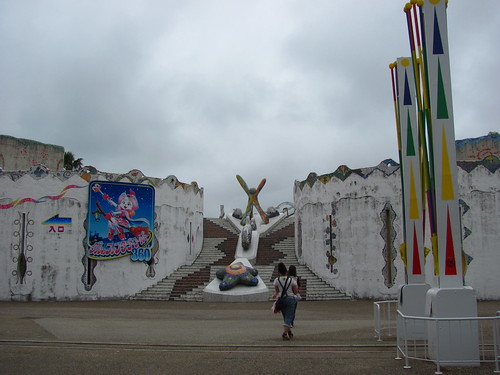






























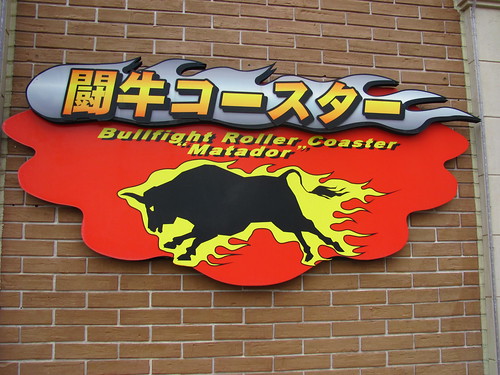






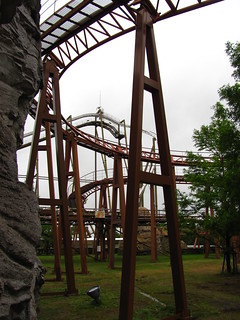








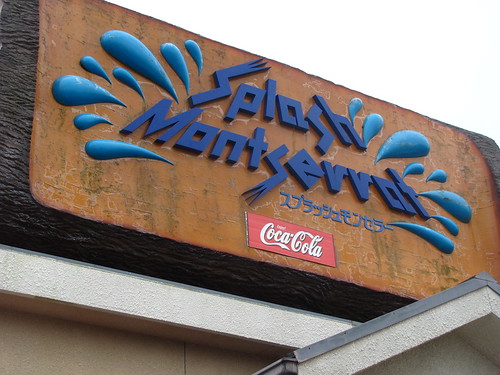

















































































Comments